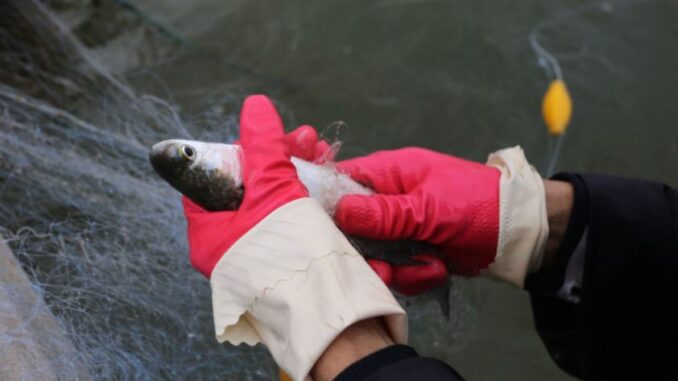
QUANG NAM – high tide, Mr. Tran Cong Quan, Tam Giang commune (Nui Thanh district) brought fishing gear to An Hoa gate to catch mullet.
An Hoa estuary covers hundreds of hectares in four communes Tam Hoa, Tam Hai, Tam Quang and Tam Giang, Nui Thanh district. This is an area of brackish water, where the tributaries of the Truong Giang River flow before entering the sea and there are many types of algae. At high tide, mullets often follow the school from the sea into this area to find food.
Knowing this feature, many people living around An Hoa estuary often catch mullet by casting a net and then knocking on the side of the boat with a wooden stick to gather the fish in, or using a net to seine an area of water.

Mr. Quan chose to besiege the net. On a motorboat with a length of more than 4m, he and a friend surfed on the water to detect fish channels. After 20 minutes of traveling, by experience he found the water about a meter deep.
At this time, the sound of the boat made many types of fish panic jump to the surface of the water. Mr. Quan turned off the engine, then gently used a bamboo pole against the boat to surf on the water. His friend, holding one end of the net, jumped into the water to start “finding” the fish.
Standing on the boat, Mr. Quan supported the moving pole and helped to let go of the net. After 15 minutes, the net more than 250 m long, 3 m high is dropped into the water to form a circle.
“The mullet that is caught in the net will find a place to escape, so the two ends of the net must be locked quickly, preventing the fish from going out,” Mr. Quan said.

When the two ends of the net are tightly closed, one end is tied to a fixed stake, and the other two fishermen use force to pull the fish. The stage of pulling the net requires them to keep the buoy floating on the water, the lead is close to the bottom to prevent the fish from coming out. The two people pulled quickly but gently to avoid the tree, the rock below to tear the net.
During the towing process, Mr. Quan observed where the buoys sank, meaning that there were large mullet caught. He paused pulling quickly holding the racket moved to catch. “Big fish often break the net to escape, so they have to be caught first, while small fish are left to remove the net when they gather,” he explained.
After more than 30 minutes, the seine net on the water surface of hundreds of square meters was narrowed to a few tens of meters, inside was a school of fish thrashing about. The two ends of the net are reduced, the person holding the buoy and the person holding the lead let them get on the boat. The fish caught they put them in ice storage containers.
Each catch takes about an hour, then the fishermen put the net on the boat and move to another area.
People who follow mullet fishing have to invest in a net of 8 million VND, use it for 2 years and a motorized boat of more than 10 million VND. “This profession does not require much technology, but you have to wade underwater all day. There are many oyster shells on the bottom of the river, sharp objects sometimes bleed,” Mr. Quan said.

Small mullet sells for 40,000 VND per kg; The medium type is 60,000 to 80,000 VND, and the large type is 150,000 VND. On a lucky day, a boat can earn a few million dong, but some days only a few fish can be caught enough to feed the family.
The mullet has a round and flat body, an average length of 20 cm, the large ones can be up to 90 cm long, can be processed into many dishes such as sauerkraut, grilled, steamed, cooked porridge…
Follow(vnexpress)
